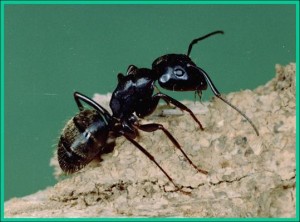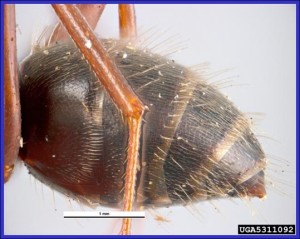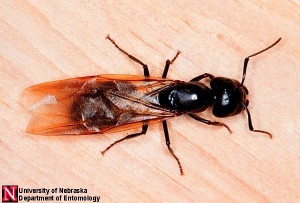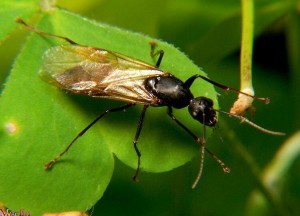
Carpenter ants
Carpenter ants (Camponotus spp.)
Carpenter ants are one of the largest and most common ants in Michigan. Unlike termites, they only nest in wood and do not eat it. Outdoors, they commonly nest in hollow trees and stumps. Finding them indoors during the summer does not necessarily mean they are nesting in your house, they may just be coming in from outside. However, the presence of carpenter ants in homes during the winter months, when it is too cold outside for ants to be active, is a very strong indication a colony of carpenter ants exists inside the building. When they do nest indoors, they prefer an enclosed space that remains wet or damp, more or less, or a permanent basis. Carpenter ants are attracted to excessive moisture conditions around windows, doors, showers, bathtubs, dishwashers, leaky pipes and drains, and under leaky roof shingles or roof vents. They have also been found in dry areas such as hollow-core doors and false beams, and blue board foam insulation.
The best method of controlling an indoor colony of carpenter ants is to locate the nest and treat it directly with a persistent insecticide registered for indoor use. Insecticides labeled for this use include cyfluthrin (sold as Bayer Advanced Home Insect Control for homeowners or Tempo for commercial applicators), Ortho’s Home Insect Defense, or similar products. Most importantly, be sure to make any repairs, if necessary, to keep the area dry. Despite claims by their manufacturers, commercially available ant bait stations are relatively ineffective in controlling carpenter ants; they are simply just too darn clever.
Finding the nest can be difficult since many of the ant’s favorite nesting sites are inaccessible. Begin looking in the rooms where the greatest numbers are found and observe where they go or come from. Carpenter ants are nocturnal and are most active at night. Carpenter ants are very tidy housekeepers and quickly remove wood shavings, food debris and dead co-workers from the nest area. In many cases, this nest debris accumulates in basements beneath the nest area, so look for accumulations of coarse sawdust and dead ants along and on top of basement walls. Try mixing 4 oz. (1/4 cup) of grape jelly with 1 teaspoon of ground up dried pet food and use this as a bait to get them feeding and carrying food back to the nest. Put a teaspoon of the bait on a jar lid or piece of foil and place out of the reach of children and pets, near where you see the ants. Hopefully, they will use the bait and lead you to their nest area.
Be sure to read and follow all the instructions and safety precautions found on the pesticide label before using any pesticide.







 Print
Print Email
Email



